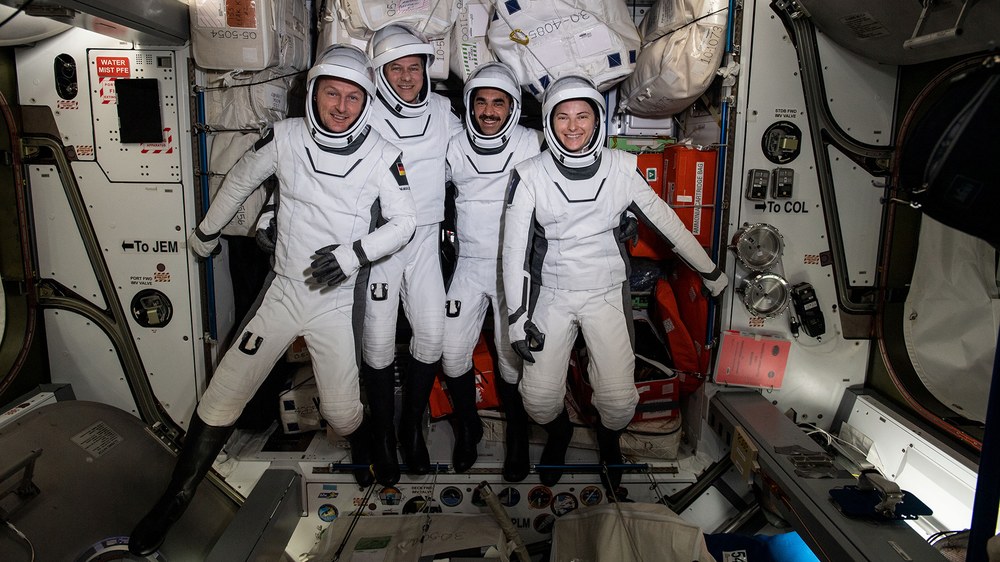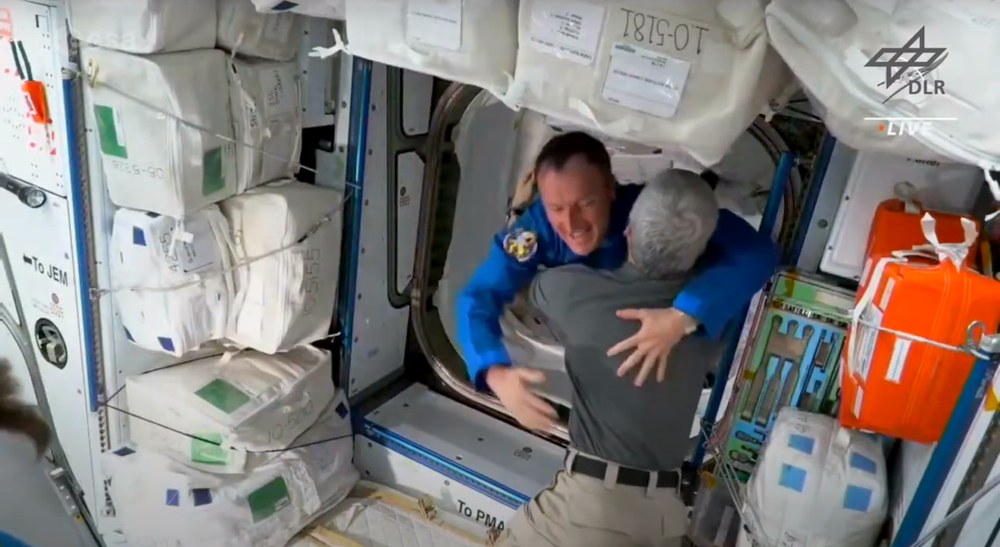Matthias Maurer is back on Earth



- On 6 May 2022 at 06:43 CEST the German ESA astronaut Matthias Maurer landed off the coast of Florida on board the crew dragon 'Endurance'.
- His first mission 'Cosmic Kiss' comes to an end after 175 days on the International Space Station.
- Matthias Maurer is expected at DLR in Cologne on the evening of 6 May 2022.
- Focus: Spaceflight, International cooperation, Cosmic Kiss
German ESA astronaut Matthias Maurer is back on Earth after spending 175 days on the International Space Station ISS. He landed in the ocean off the coast of Florida on 6 May 2022 at 00:43 local time (06:43 CEST) aboard the Dragon capsule 'Endurance' with crewmates Kayla Barron, Raja Chari and Thomas Marshburn – all NASA astronauts. They left the ISS at 07:20 CEST on 5 May and arrived on Earth after a 23.5-hour flight.
On 11 November 2021, the 52-year-old materials scientist became the first German to launch to the ISS aboard a Crew Dragon spacecraft operated by US company SpaceX. His first mission to the ISS, Cosmic Kiss, began on 12 November when he arrived at the Space Station. The Saarland native conducted more than 100 experiments, including 34 from Germany, in microgravity at 28,000 kilometres per hour 400 kilometres above the Earth. The German Aerospace Center (Deutsches Zentrum für Luft- und Raumfahrt; DLR) is involved in the 'Cosmic Kiss' mission in numerous ways. The German Space Agency at DLR was responsible for selecting and coordinating the experiments and contributions from Germany. DLR scientists also conducted their own experiments. ESA's Columbus Control Centre, based at the German Space Operations Center at DLR in Oberpfaffenhofen, is responsible for the planning and implementation of the experiments that take place in the European Columbus module on the ISS.

Best of Cosmic Kiss
Your consent to the storage of data ('cookies') is required for the playback of this video on Youtube.com. You can view and change your current data storage settings at any time under privacy.
Deutsche Raumfahrtagentur im DLR
"Germany is a sought-after partner in international spaceflight. The knowledge and skills of all those who participated in the Cosmic Kiss mission on Earth played a major role in the success of Matthias Maurer's flight," emphasises Anke Kaysser-Pyzalla, Chair of the DLR Executive Board. "The German ESA astronaut was involved in more than 100 experiments, 34 of them from Germany. Further analysis of the results back on Earth will show how successful the experiments were. Results from the mission will help us to better understand terrestrial problems in biology, medicine and materials science, among others, and thus be able to find solutions to them."
"We are pleased and relieved that Matthias Maurer is back on Earth in good health. We congratulate him on his first successful ISS mission, which faced particular challenges – including in terms of global politics," adds Walther Pelzer, DLR Executive Board member and Head of the German Space Agency at DLR. "Cosmic Kiss is a great success because the mission has once again shown the importance of environmental sustainability. As the most important European partner of the international Space Station, Germany is focusing on research for the future – and on peaceful international cooperation."
Mission featuring space tourists and an extravehicular activity
Matthias Maurer is the fourth German on the Space Station and part of the ISS long-duration crews 66 and 67. He experienced the partial evacuation of the ISS shortly after his arrival on 15 November 2021 to avoid a potential collision with fragments of a decommissioned satellite. Thankfully, no collision occurred. The ISS has also hosted space tourists twice for several days in the past six months: In December 2021, for the first time in 12 years, two Japanese visitors spent 10 days on the station, accompanied by a Russian cosmonaut. This was followed in April by the two-week visit of the first commercial ISS crew from US company Axiom Space.
On 23 March, Matthias Maurer conducted a joint extravehicular activity (EVA) with NASA astronaut Raja Chari for six hours and 54 minutes. Together, the two astronauts installed new hoses on a cooling system, replaced a camera and connected a power and data cable to the European Bartolomeo external platform. This EVA was the 441st in space history. On 28 April, Matthias Maurer welcomed his colleague Samantha Christoforetti on the ISS. The Italian ESA astronaut succeeds Maurer on the ISS with her second mission 'Minerva'.
Matthias Maurer has spent approximately 4100 hours on the International Space Station. He has orbited Earth more than 2700 times and experienced almost 2800 sunrises and sunsets. Maurer wore the new EMS suit often, including during exercise, and he also did an above-average amount of work for the 'Touching Surfaces' experiment conducted in cooperation with Saarland University, which focuses on the microbial contamination of surfaces. He has also produced more sustainable concrete in microgravity and conducted a series of experiments on bioplasters using a 3D printer. "Most of his experiments were in the fields of materials science, human physiology, technology and the promotion of young scientists," sums up DLR 'Cosmic Kiss' Mission Manager Volker Schmid. Getting children and young people excited about spaceflight and STEM subjects in particular were also the focus of Cosmic Kiss. Maurer is an ambassador for the Children's Heart Foundation and has also supported DLR school campaigns from the ISS.
From the Space Station directly to the aerospace medical centre at DLR
The German ESA astronaut is scheduled to arrive in Germany at around 22:30 CEST on 6 May. At the :envihab research facility at DLR in Cologne, Matthias Maurer will be welcomed by DLR and ESA staff and will receive round-the-clock care for the next 14 days.
"We are delighted that Matthias Maurer’s first stop following his return from space will be :envihab. It provides the ideal conditions to recover from the months in space. Our highly specialised team will take the best possible care of him and can thus contribute to the successful completion of the Cosmic Kiss mission," emphasises Jens Jordan, Head of the DLR Institute of Aerospace Medicine. Maurer's 'Direct Return' is already the eighth time that European astronauts have stayed at DLR's aerospace medicine research facility – previously, French astronaut Thomas Pesquet (2021 and 2017), Italian astronaut Luca Parmitano (2020), German astronaut Alexander Gerst (2018 and 2014), British astronaut Timothy Peake (2016) and Danish astronaut Andreas Mogensen (2015) have readjusted to conditions on Earth here.
No successful mission without ground control
Whether it was an extravehicular activity, scientific experiments or live events – while Matthias Maurer was orbiting the Earth on the ISS, he was always in close contact with the Columbus Control Centre, which is located at the German Space Operations Centre at DLR in Oberpfaffenhofen. Around 50 employees ensure that the European research laboratory on the ISS – the Columbus module – is fully operational at all times during all ESA missions. They provided Maurer with continuous support during his many and varied tasks.
Columbus Flight Director Stefan Neumann praises the collaboration with the German ESA astronaut: "It is great to see that Matthias Maurer was able to successfully carry out numerous experiments from a wide range of research fields during his Cosmic Kiss mission. Working with him has been a great pleasure for all of us."
